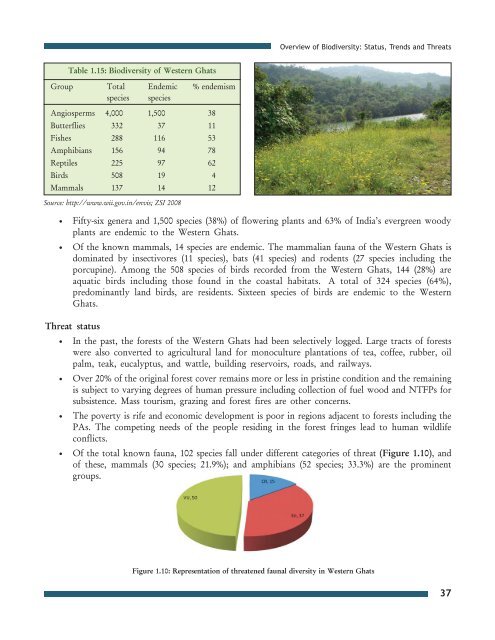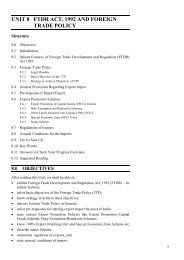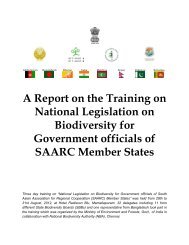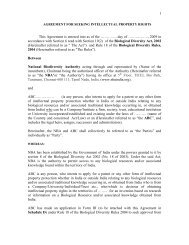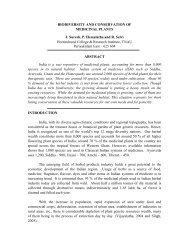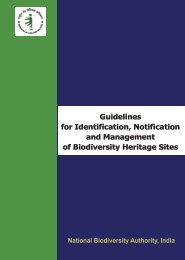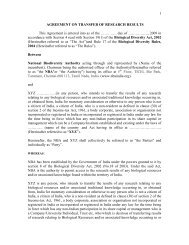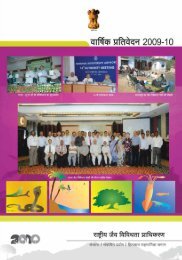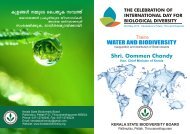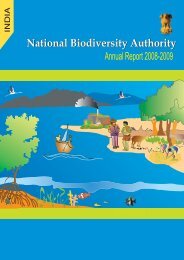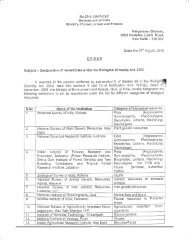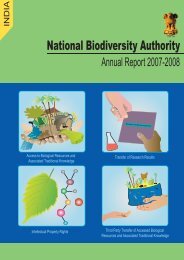Part 1 - English version (PDF) - Convention on Biological Diversity
Part 1 - English version (PDF) - Convention on Biological Diversity
Part 1 - English version (PDF) - Convention on Biological Diversity
Create successful ePaper yourself
Turn your PDF publications into a flip-book with our unique Google optimized e-Paper software.
Overview of Biodiversity: Status, Trends and Threats<br />
Table 1.15: Biodiversity of Western Ghats<br />
Group Total Endemic % endemism<br />
species species<br />
Angiosperms 4,000 1,500 38<br />
Butterflies 332 37 11<br />
Fishes 288 116 53<br />
Amphibians 156 94 78<br />
Reptiles 225 97 62<br />
Birds 508 19 4<br />
Mammals 137 14 12<br />
Source: http://www.wii.gov.in/envis; ZSI 2008<br />
<br />
<br />
Fifty-six genera and 1,500 species (38%) of flowering plants and 63% of India’s evergreen woody<br />
plants are endemic to the Western Ghats.<br />
Of the known mammals, 14 species are endemic. The mammalian fauna of the Western Ghats is<br />
dominated by insectivores (11 species), bats (41 species) and rodents (27 species including the<br />
porcupine). Am<strong>on</strong>g the 508 species of birds recorded from the Western Ghats, 144 (28%) are<br />
aquatic birds including those found in the coastal habitats. A total of 324 species (64%),<br />
predominantly land birds, are residents. Sixteen species of birds are endemic to the Western<br />
Ghats.<br />
Threat status<br />
In the past, the forests of the Western Ghats had been selectively logged. Large tracts of forests<br />
were also c<strong>on</strong>verted to agricultural land for m<strong>on</strong>oculture plantati<strong>on</strong>s of tea, coffee, rubber, oil<br />
palm, teak, eucalyptus, and wattle, building reservoirs, roads, and railways.<br />
Over 20% of the original forest cover remains more or less in pristine c<strong>on</strong>diti<strong>on</strong> and the remaining<br />
is subject to varying degrees of human pressure including collecti<strong>on</strong> of fuel wood and NTFPs for<br />
subsistence. Mass tourism, grazing and forest fires are other c<strong>on</strong>cerns.<br />
The poverty is rife and ec<strong>on</strong>omic development is poor in regi<strong>on</strong>s adjacent to forests including the<br />
PAs. The competing needs of the people residing in the forest fringes lead to human wildlife<br />
c<strong>on</strong>flicts.<br />
Of the total known fauna, 102 species fall under different categories of threat (Figure 1.10), and<br />
of these, mammals (30 species; 21.9%); and amphibians (52 species; 33.3%) are the prominent<br />
groups.<br />
Figure 1.10: Representati<strong>on</strong> of threatened faunal diversity in Western Ghats<br />
37


